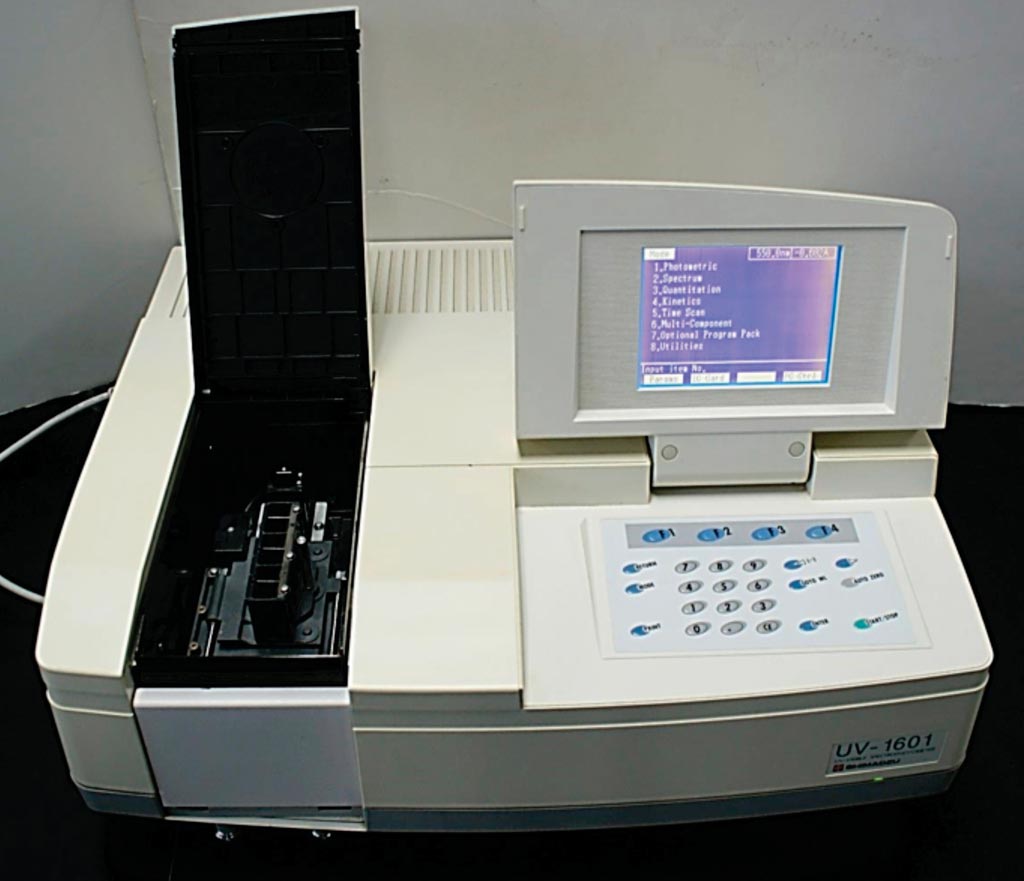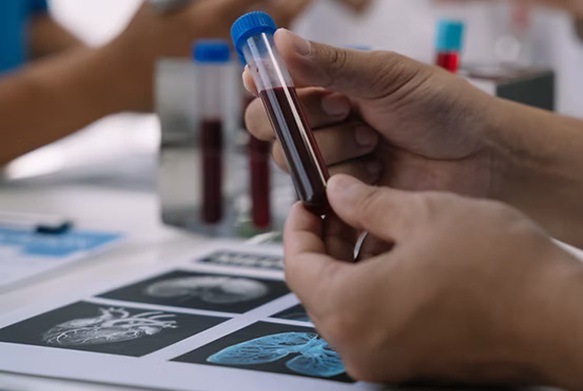Combined Urinary Procedure Used to Diagnosis Mucopolysaccharidoses
|
By LabMedica International staff writers Posted on 18 Jan 2017 |

Image: The Shimadzu ultra violet–visible 1601 spectrophotometer (Photo courtesy of Shimadzu).
Mucopolysaccharidoses (MPS) are a group of rare genetic disorders of glycosaminoglycan (GAG) metabolism caused by the deficiency of one of the lysosomal enzymes required for GAG degradation. The diseases are characterized by the accumulation of undegraded glycosaminoglycans in lysosomes in multiple organs and by their excretion in high amounts in urine.
An early and accurate diagnosis of MPS is critical not only to permit disease-specific genetic counselling but also to guide appropriate supportive care and disease-specific therapy, when available. The first steps in the laboratory diagnosis of MPS suspected patients are based on the quantitative and qualitative analysis of urinary GAGs consisting of their quantitative as well as qualitative evaluation.
Scientists at the Marche Polytechnic University carried out retrospective study analyzing 2,154 normal urine samples and 210 samples from 73 patients affected by different types of Mucopolysaccharidoses. The glycosaminoglycans were quantified by a dimethylmethylene blue (DMB) method and size-fractionated by a modified one-dimensional electrophoresis method.
Untreated urine samples were analyzed for total GAG content using the DMB test and spectrophotometric measurements were recorded on a Shimadzu UV–visible 1601 spectrophotometer. Creatinine concentration was determined on 100 μL of urine by a Spotchem SP-4430 analyzer. Electrophoretic GAG characterization was performed using cellulose acetate membranes.
The investigators found that the combination of the two methods allowed identifying all the patients affected by the different types of Mucopolysaccharidosis with 100% sensitivity and specificity. The differences between the means displayed according to age values of the control samples and the corresponding values of the MPS patients are statistically significant in all groups with at least more than three samples. Out of 2,154 samples of normal subjects, an increased GAG concentration was found in 259 (12%) samples; however, none of them showed a pathological pattern at the electrophoresis.
The authors concluded that that the combined use of DMB test and electrophoresis allows the identification of all patients affected by MPS with 100% sensitivity and specificity. Moreover, this diagnostic approach provides useful information to proceed with further laboratory and diagnostic confirmatory tests, from enzyme assay to genetic analyses. The study was published in the January 2017 issue of the journal Clinica Chimica Acta.
An early and accurate diagnosis of MPS is critical not only to permit disease-specific genetic counselling but also to guide appropriate supportive care and disease-specific therapy, when available. The first steps in the laboratory diagnosis of MPS suspected patients are based on the quantitative and qualitative analysis of urinary GAGs consisting of their quantitative as well as qualitative evaluation.
Scientists at the Marche Polytechnic University carried out retrospective study analyzing 2,154 normal urine samples and 210 samples from 73 patients affected by different types of Mucopolysaccharidoses. The glycosaminoglycans were quantified by a dimethylmethylene blue (DMB) method and size-fractionated by a modified one-dimensional electrophoresis method.
Untreated urine samples were analyzed for total GAG content using the DMB test and spectrophotometric measurements were recorded on a Shimadzu UV–visible 1601 spectrophotometer. Creatinine concentration was determined on 100 μL of urine by a Spotchem SP-4430 analyzer. Electrophoretic GAG characterization was performed using cellulose acetate membranes.
The investigators found that the combination of the two methods allowed identifying all the patients affected by the different types of Mucopolysaccharidosis with 100% sensitivity and specificity. The differences between the means displayed according to age values of the control samples and the corresponding values of the MPS patients are statistically significant in all groups with at least more than three samples. Out of 2,154 samples of normal subjects, an increased GAG concentration was found in 259 (12%) samples; however, none of them showed a pathological pattern at the electrophoresis.
The authors concluded that that the combined use of DMB test and electrophoresis allows the identification of all patients affected by MPS with 100% sensitivity and specificity. Moreover, this diagnostic approach provides useful information to proceed with further laboratory and diagnostic confirmatory tests, from enzyme assay to genetic analyses. The study was published in the January 2017 issue of the journal Clinica Chimica Acta.
Latest Clinical Chem. News
- ‘Brilliantly Luminous’ Nanoscale Chemical Tool to Improve Disease Detection
- Low-Cost Portable Screening Test to Transform Kidney Disease Detection
- New Method Uses Pulsed Infrared Light to Find Cancer's 'Fingerprints' In Blood Plasma
- Carbon Nanotubes Help Build Highly Accurate Sensors for Continuous Health Monitoring
- Paper-Based Device Boosts HIV Test Accuracy from Dried Blood Samples
- AI-Powered Raman Spectroscopy Method Enables Rapid Drug Detection in Blood
- Novel LC-MS/MS Assay Detects Low Creatinine in Sweat and Saliva
- Biosensing Technology Breakthrough Paves Way for New Methods of Early Disease Detection
- New Saliva Test Rapidly Identifies Paracetamol Overdose
- POC Saliva Testing Device Predicts Heart Failure in 15 Minutes

- Screening Tool Detects Multiple Health Conditions from Single Blood Drop
- Integrated Chemistry and Immunoassay Analyzer with Extensive Assay Menu Offers Flexibility, Scalability and Data Commutability
- Rapid Drug Test to Improve Treatment for Patients Presenting to Hospital
- AI Model Detects Cancer at Lightning Speed through Sugar Analyses
- First-Ever Blood-Powered Chip Offers Real-Time Health Monitoring
- New ADLM Guidance Provides Expert Recommendations on Clinical Testing For Respiratory Viral Infections
Channels
Molecular Diagnostics
view channel
Simple Blood Test Better Predicts Heart Disease Risk
Cardiovascular diseases (CVDs) are the primary cause of death worldwide. A large proportion of these cases could be prevented by addressing lifestyle and environmental factors such as smoking, poor diet,... Read more
New Blood Test Detects 12 Common Cancers Before Symptoms Appear
Bowel cancer is the fourth most common cancer in the UK, with over 42,000 new diagnoses each year. Detecting bowel cancer in its early stages can be challenging, and as the disease progresses, survival... Read moreHematology
view channel
New Scoring System Predicts Risk of Developing Cancer from Common Blood Disorder
Clonal cytopenia of undetermined significance (CCUS) is a blood disorder commonly found in older adults, characterized by mutations in blood cells and a low blood count, but without any obvious cause or... Read more
Non-Invasive Prenatal Test for Fetal RhD Status Demonstrates 100% Accuracy
In the United States, approximately 15% of pregnant individuals are RhD-negative. However, in about 40% of these cases, the fetus is also RhD-negative, making the administration of RhoGAM unnecessary.... Read moreImmunology
view channel
Stem Cell Test Predicts Treatment Outcome for Patients with Platinum-Resistant Ovarian Cancer
Epithelial ovarian cancer frequently responds to chemotherapy initially, but eventually, the tumor develops resistance to the therapy, leading to regrowth. This resistance is partially due to the activation... Read more
Machine Learning-Enabled Blood Test Predicts Immunotherapy Response in Lymphoma Patients
Chimeric antigen receptor (CAR) T-cell therapy has emerged as one of the most promising recent developments in the treatment of blood cancers. However, over half of non-Hodgkin lymphoma (NHL) patients... Read moreMicrobiology
view channel
Handheld Device Delivers Low-Cost TB Results in Less Than One Hour
Tuberculosis (TB) remains the deadliest infectious disease globally, affecting an estimated 10 million people annually. In 2021, about 4.2 million TB cases went undiagnosed or unreported, mainly due to... Read more
New AI-Based Method Improves Diagnosis of Drug-Resistant Infections
Drug-resistant infections, particularly those caused by deadly bacteria like tuberculosis and staphylococcus, are rapidly emerging as a global health emergency. These infections are more difficult to treat,... Read more
Breakthrough Diagnostic Technology Identifies Bacterial Infections with Almost 100% Accuracy within Three Hours
Rapid and precise identification of pathogenic microbes in patient samples is essential for the effective treatment of acute infectious diseases, such as sepsis. The fluorescence in situ hybridization... Read morePathology
view channel
Sensitive and Specific DUB Enzyme Assay Kits Require Minimal Setup Without Substrate Preparation
Ubiquitination and deubiquitination are two important physiological processes in the ubiquitin-proteasome system, responsible for protein degradation in cells. Deubiquitinating (DUB) enzymes contain around... Read more
World’s First AI Model for Thyroid Cancer Diagnosis Achieves Over 90% Accuracy
Thyroid cancer is one of the most common cancers worldwide, and its precise management typically relies on two primary systems: (1) the 8th edition of the American Joint Committee on Cancer (AJCC) or ... Read more
Breakthrough Diagnostic Approach to Significantly Improve TB Detection
Tuberculosis (TB) remains the deadliest infectious disease globally, with 10.8 million new cases and 1.25 million deaths reported in 2023. Early detection through effective screening is crucial in identifying... Read more
Rapid, Ultra-Sensitive, PCR-Free Detection Method Makes Genetic Analysis More Accessible
Genetic testing has been an important method for detecting infectious diseases, diagnosing early-stage cancer, ensuring food safety, and analyzing environmental DNA. For a long time, polymerase chain reaction... Read moreTechnology
view channel
Disposable Microchip Technology Could Selectively Detect HIV in Whole Blood Samples
As of the end of 2023, approximately 40 million people globally were living with HIV, and around 630,000 individuals died from AIDS-related illnesses that same year. Despite a substantial decline in deaths... Read more
Pain-On-A-Chip Microfluidic Device Determines Types of Chronic Pain from Blood Samples
Chronic pain is a widespread condition that remains difficult to manage, and existing clinical methods for its treatment rely largely on self-reporting, which can be subjective and especially problematic... Read more
Innovative, Label-Free Ratiometric Fluorosensor Enables More Sensitive Viral RNA Detection
Viruses present a major global health risk, as demonstrated by recent pandemics, making early detection and identification essential for preventing new outbreaks. While traditional detection methods are... Read moreIndustry
view channel
Cepheid and Oxford Nanopore Technologies Partner on Advancing Automated Sequencing-Based Solutions
Cepheid (Sunnyvale, CA, USA), a leading molecular diagnostics company, and Oxford Nanopore Technologies (Oxford, UK), the company behind a new generation of sequencing-based molecular analysis technologies,... Read more
Grifols and Tecan’s IBL Collaborate on Advanced Biomarker Panels
Grifols (Barcelona, Spain), one of the world’s leading producers of plasma-derived medicines and innovative diagnostic solutions, is expanding its offer in clinical diagnostics through a strategic partnership... Read more




















